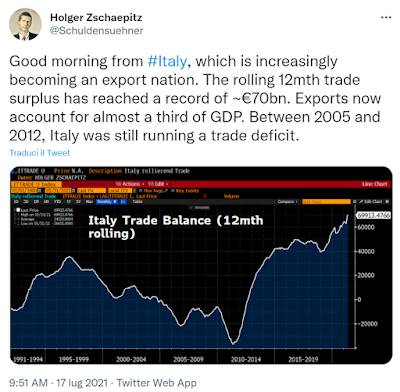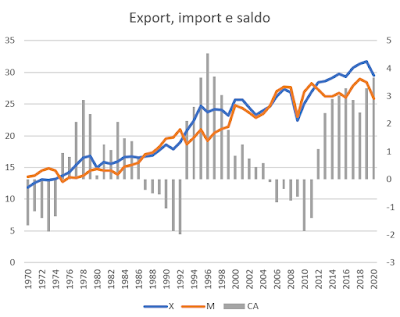The exporting country
Anyone who has been here for a while certainly remembers our friend who has the habit of driving the wrong way on the highway: he is a conspiracy theorist , but he is a very good person. A few days ago he made another one:
(the original tweet is here ).
Now you will tell me: but what is wrong with this graph? After all, they are just data!
Yes, of course: they are just data, and they only tell a piece of history, not only and not so much because they start from 1991 (which would also be enough), but because they show us only the balance between exports and imports of goods and services (the trade balance), without showing us how the respective components, i.e. exports and imports, have moved. There is nothing wrong with not showing it, but there is also nothing wrong with showing it, and so I show it to you using the usual ISTAT data . The graph (on annual data rather than on a moving average of monthly data, which substantially changes nothing in the "low frequency", ie long-term, information that interests me), is this:
where the unit of measurement is the percentage point of GDP, exports are blue, imports orange, and the balance is represented by the gray bar graph (right-hand scale).
What does this graph tell you? That from 1970 to today (you could go even further back) there have been three quite violent corrections of our country's balance of payments deficit: one between 1974 and 1975, one between 1992 and 1993, and one between 2011 and 2012.
Now, we have already talked about the different nature of these corrections, in particular the last two, but we should talk about it again for a moment.
In fact, the current account balance (the gray bars), given by the difference between exports and imports, can change sign, passing from negative to positive (from bottom to top) for two reasons: either because exports are increasing, or because imports are decreasing (the two movements can obviously coexist and therefore add up). Exports depend on the income of the rest of the world, and on their relative price, the real exchange rate (ratio between Italian and foreign prices expressed in the same currency, a concept explained here ). Imports depend on Italian income and again on the real exchange rate. Of course, the Italian government, which already has its work to do in ensuring the survival of Italians, in these difficult times, has never been particularly able to influence the income of the rest of the world, which means, in essence, that to increase its exports Italy can only leverage the real exchange rate. Another story for imports: since these depend on Italian income, and the Italian government controls this income a little, even in the absence of exchange rate maneuvers, imports can be maneuvered by affecting income.
Simply, if you want the Italians as a whole to care less, their total income must be lower, that is, austerity is needed. Of course, the adjustment based on income becomes indispensable when it is not possible to resort to the adjustment of relative prices, or at least to a sufficiently rapid adjustment ( and this too we have talked about ).
To show where I want to go, let's consider the size of the balance adjustment between the year before the correction and the positive peak after the correction. After the -1.33% reached by the balance of trade in 1974, the peak came with 2.85% in 1978: a correction of 4.18 percentage points of the balance of which 3.38 due to an increase in exports, and 0.80 to a decrease in imports. The import correction was therefore 19% of the total correction (0.8 / 4.18 = 0.19). After -1.98% in 1992, the correction was much stronger: the current account balance reached 4.53% in 1996, with an increase of 6.52 points, of which 4.75 due to an increase in exports and 1.76 due to a decrease in imports. : the decrease in imports, in this case, accounted for 27% of the total adjustment. And let's get to today: after -1.4 in 2011, the peak was reached with 3.66 in 2020, with an overall correction of 5.06 points, of which 2.61 due to an increase in exports, and 2.44 to a decrease in imports. In this case, therefore, up to now, the correction has been about half (48%) of the decrease in imports.
Is it clear now what is wrong with our German brother's speech?
It is not very accurate to say that Italy "is increasingly becoming an export nation". We are not more and more an exporting nation: we are above all less and less an importing nation, for the simple reason that our income before COVID was stuck at that of fifteen years earlier (i.e. in 2019 we had the aggregate income of 2005). The graph is clear: this last adjustment (that of 2012) depends above all on the fact that imports stop: it is austerity, beauty!
And starting from here, many interesting considerations could be developed, which we give up developing a little because we have already done so many times, and a little because we have other things to do. See you later live FB on the page of colleague Siri …
This is a machine translation of a post (in Italian) written by Alberto Bagnai and published on Goofynomics at the URL https://goofynomics.blogspot.com/2021/07/il-paese-esportatore.html on Sun, 18 Jul 2021 17:53:00 +0000. Some rights reserved under CC BY-NC-ND 3.0 license.


